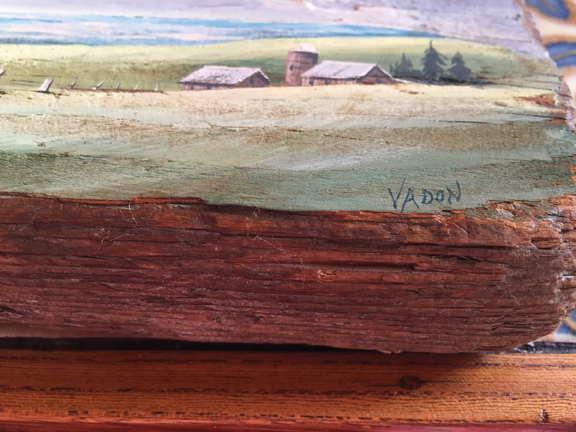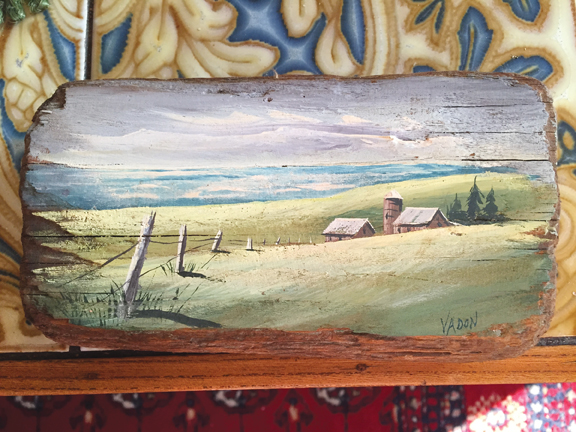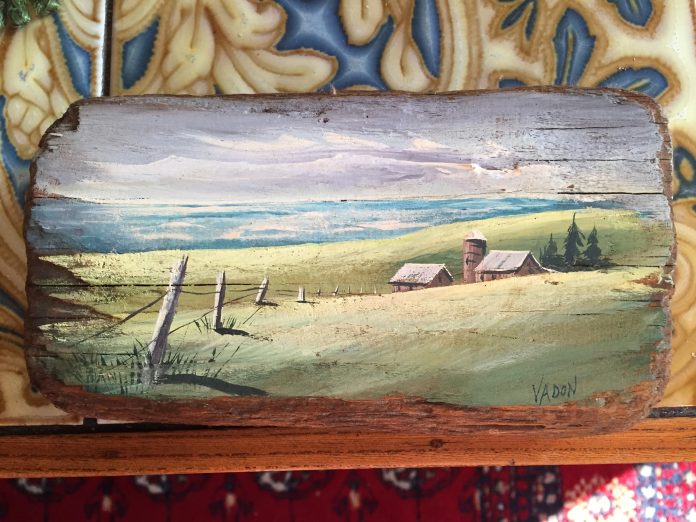Hi Shaun,
This piece was bought by my mother about 15 years ago at a secondhand store in Nevada. It’s painted on wood. It’s about 10” wide, maybe an inch or so thick. I don’t expect it has any value, but I do think it’s a neat little piece and was wondering if you could tell us more about it.
JB


Hi JB,
Thank you for sending along the photos of this interesting piece of artwork.
You said in your email that this painting on board was purchased in Nevada. Given the subject matter, it may have well originated there but quite possibly, it was transported there by a traveller from the east.
To my eye, the work has a fairly accomplished feel to it, which suggests that the artist had some academic training. This removes it from the realm of “folk art” which are works created by individuals with typically no formal training or knowledge of the rules of art.
The signature “Vadon” in upper case letters also has a “trained” look to it, which suggests to me that this artist likely painted many or at least several of these scenes on wood, perhaps for sale to tourists. Given the generic nature of the image, I’d suggest that this is a scene the artist conjured up from memory or simply invented to suit his purpose.
I’ve seen this style of commercial painting frequently and many well- trained artists – Graham Norwell (1901 – 1967) comes to mind – have resorted to this type of popular style and subject. In Norwell’s case he painted many watercolours of rural Quebec winter scenes that he sold quickly for a few dollars.
Painting something that will sell as opposed to exploring your artistic vision is an understandable temptation. It’s only fair to point out that some of Canada’s best known folk artists – like Maud Lewis (1903 – 1970) of Marshalltown, NS – created paintings that were sold to passing tourists. Ms. Lewis frequently included animals and people in her paintings. The scenes from her childhood that she painted so frequently have become some of the most iconic images in Canadian folk art. The key difference is that Ms. Lewis had little if any formal art training.
Not surprisingly, some folk artists are hesitant to paint people and animals into their work. It’s a challenge to do so and therefore not surprising that one sees so many landscape paintings but relatively few by comparison with animals and or people.
In the case of your Vadon painting, I think he or she would have had little difficulty in painting more visually interesting paintings than the simple landscape your mother purchased. But perhaps, this pastoral landscape subject was a more popular item. In any event, your little painting on board is a fun, decorative piece with a certain amount of sentimental value since you acquired it from your mother. In terms of its commercial value, I would put a replacement price on it of roughly $50. Thanks again for sending the photo to me.
Shaun Markey is the author of a recently published memoir called Folk Art in the Attic. He also blogs about antiques and folk art at folkartintheattic.blogspot.ca. If you have an antique or collectable and are curious about its past and approximate value, email a photo or two to shaunmarkey@rogers.com. Please make sure photos are high enough resolution so that details are visible. Any extra information about your treasure is helpful too. Your item – and its story – might just be published in the next column.
